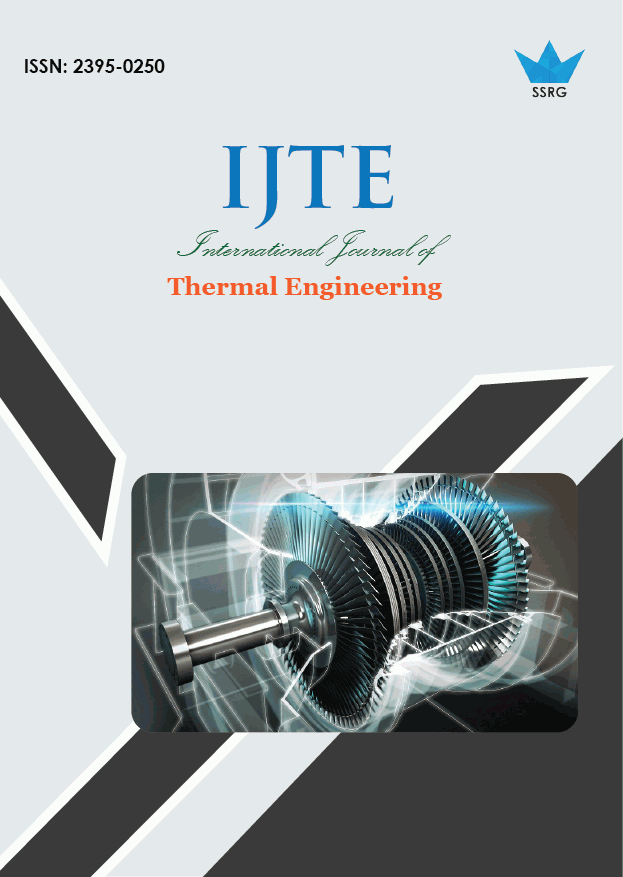A review of the most important cooling techniques to improve the performance of the photovoltaic cell

| International Journal of Thermal Engineering |
| © 2020 by SSRG - IJTE Journal |
| Volume 6 Issue 3 |
| Year of Publication : 2020 |
| Authors : Mohammed Salih Safar, Dr. Adnan M.A. Saffawi, Dr. Ahmed Fattah Ahmed |
How to Cite?
Mohammed Salih Safar, Dr. Adnan M.A. Saffawi, Dr. Ahmed Fattah Ahmed, "A review of the most important cooling techniques to improve the performance of the photovoltaic cell," SSRG International Journal of Thermal Engineering, vol. 6, no. 3, pp. 6-10, 2020. Crossref, https://doi.org/10.14445/23950250/IJTE-V6I3P102
Abstract:
Photovoltaic (PV) units operate in a contradiction; solar radiation is the essential input to produce electricity with Photovoltaic cells, but they drop in performance when the temperature increase by radiation. This work reviews the most important literature related to the research works submitted to achieve improved efficiency via convenient cooling systems. The passive cooling methods reduce the photovoltaic unit temperature in the range of 6-18 °C and enhance electrical efficiency up to 15 % maximum. While active cooling techniques, the performance is better as a reduction in photovoltaic unit temperature achieve to 33 °C. and an enhancement in electrical efficiency up to 22.2%. It can be expected that with the exponential growth of solar photovoltaic electricity worldwide, a compatible cooling system has become mandatory to ensure better harvest and use of energy.
Keywords:
photovoltaic; efficiency; solar radiation; electricity.
References:
[1] C. Popovici, S. Hudișteanu, T. Mateescu, N. Cherecheș, “Efficiency improvement of photovoltaic panels using air-cooled heat sinks”, Energy Procedia 85 (2016) 425 – 432.
[2] S. Reddy, M. Ebadian, C. Lin, “A review of PV–T systems: Thermal management and efficiency with single-phase cooling”, International Journal of Heat and Mass Transfer 91 (2015) 861–871.
[3] N. Zaini, M. Ab Kadir, M. Izadi, N. Ahmad, M. Radzi, A. Aziz, “The Effect of Temperature on a Mono-crystalline Solar PV Panel”, 2015 IEEE Conference on Energy Conversion.
[4] M.M. Rahman, M. Hasanuzzaman, N.A. Rahim, “Effects of various parameters on PV-module power and efficiency”, Energy Conversion and Management 103 (2015) 348-358.
[5] E. Cuce, T. Bali, S.A. Sekucoglu, “Effects of passive cooling on silicon photovoltaic cells' performance”, International Journal of Low-Carbon Technologies 2011, 6, 299-308.
[6] R. Mazón-Hernández, J.R. García-Cascales, F. Vera-García, A.S. Káiser, B. Zamora, “Improving the Electrical Parameters of a Photovoltaic Panel by Means of an Induced or Forced Air Stream”,
International Journal of Photoenergy, 2013.
[7] A. Hassan, “Phase Change Materials for Thermal Regulation of Building Integrated Photovoltaics, Doctoral Thesis”, Dublin Institute of Technology, 2010.
[8] S. Maiti, S. Banerjee, K. Vyas, P. Patel, P.K. Ghosh, “Self-regulation of photovoltaic module temperature in V-trough using a metal–wax composite phase change matrix”, Solar Energy 85 (2011) 1805–1816.
[9] M. Rosa-Clot, P. Rosa-Clot, G.M. Tina, P.F. Scandura, “Submerged photovoltaic solar panel: SP2”, Renewable Energy 35 (2010) 1862–1865.
[10] I. El-Seesy, T. Khalil, M.T. Ahmed, “Experimental Investigations and Developing of Photovoltaic/Thermal System”, World Applied Sciences Journal 19(9), 1342-1347, 2012.
[11] M. Chandrasekar, S. Suresh, T. Senthilkumar, M.G. Karthikeyan, “Passive cooling of the standalone flat PV module with cotton wick structures”, Energy Conversion and Management 71 (2013) 43–50
[12] S. Sami, "Prediction of Behavior of Thermal Storage, PV-Thermal Solar Collector with Nanofluids and Phase Change Material" SSRG International Journal of Thermal Engineering 6.1
[13] (2020): 11-27.S.A. Abdulgafar, S.O. Omar, K.M. Yousif, “Improving The Efficiency of Polycrystalline Solar Panel Via Water Immersion Method”, International Journal of Innovative Research in Science, Engineering and Technology, Vol. 3, Issue 1, January 2014.
[14] X. Zhang, X. Zhao, S. Smith, J. Xu, X. Yu, (2012) “Review of R&D progress and practical application of solar photovoltaic/thermal (PV/T) technologies”, Renewable and Sustainable Energy Review.
[15] R. F. Russell, Uniform temperature heat pipe and method of using the same, USA patent no. Patent US4320246.
[16] W.O. Anderson, P.M. Dussinger, D.B. Sarraf, S. Tamanna, “Heat Pipe Cooling of Concentrating Photovoltaic (CPV) Systems”, Conference Record of the IEEE Photovoltaic Specialists Conference, 2008.
[17] X. Tang, Z. Quan, Y. Zhao, “Experimental Investigation of Solar Panel Cooling by a Novel Micro Heat Pipe Array”, Energy, and Power Engineering, 2010, 2, 171-174.
[18] P. Gang, F. Huide, Z. Huijuan, J. Jie, “Performance Study and Parametric Analysis of a Novel Heat Pipe PV/T System”, Energy 37 (2012) 384e395.
[19] S. Wu, Q.L. Zhang, L. Xiao, F. Guo, “A heat pipe photovoltaic/thermal (PV/T) hybrid system and its performance evaluation”, 2011 Energy and Buildings, 43(12).
[20] Z. Farhana, Y.M. Irwan, R.M. Azimmi, N. Gomesh, “Experimental Investigation of Photovoltaic Modules Cooling System”, IEEE Symposium on Computers & Informatics 2012.
[21] N. Arcuri, F. Reda, M. De Simone, “Energy and thermo-fluid-dynamics evaluations of photovoltaic panels cooled by water and air”, Solar Energy 105 (2014) 147–156.
[22] B. Du, E. Hu, M. Kolhe, “Performance Analysis of Water Cooled Concentrated Photovoltaic (CPV) System”, Renewable and Sustainable Energy Reviews 16 (2012) 6732-6736.
[23] H. Bahaidarah, “Performance evaluation of a PV (photovoltaic) module by back surface water cooling for hot climatic conditions”, Energy 59 (2013) 445-453.
[24] L. Dorobanțu, “Experimental Assessment of PV Panels Front Water Cooling Strategy”, Renewable Energy and Power Quality Conference 2013.
[25] N. Karami, M. Rahimi, “Heat transfer enhancement in a PV cell using Boehmite nanofluid”, Energy Conversion and Management 86 (2014) 275–285.
[26] M. Sardarabadi, M. Passandideh-Fard, S.Z. Heris, “Experimental investigation of the effects of silica/water nanofluid on PV/T (photovoltaic thermal units)”, Energy 66 (2014) 264-272.
[27] H. Najafi, K.A. Woodbury, Optimization of a cooling system based on the Peltier effect for photovoltaic cells, Solar Energy 91 (2013) 152–160.
[28] X. Han, Y. Wang, L. Zhu, “The Performance and Long-term Stability of Silicon Concentrator Solar Cells Immersed in Dielectric Liquids”, Energy Conversion and Management 66 (2013) 189–198.

 10.14445/23950250/IJTE-V6I3P102
10.14445/23950250/IJTE-V6I3P102